You should already know the importance of a cooldown. Now it’s time to get the most out of yours. Regardless if it’s running, weight training or a bodyweight session, if the same 3-minute jog and quick calf stretch is as far as your post-workout routine goes, you need to switch things up. Similar to choosing a training method that matches your goal, your cooldown should be carefully selected to do the same. Below are 4 cooldown approaches that will help bring your body back to its normal state, taking into account the previous training method, stimulus and duration.
First things first – regardless of the type or intensity of your workout, a sufficient amount of water is required to transport nutrients throughout your entire body. That’s why the first step of your cooldown should always be to fully hydrate. Once that’s done, you can begin to bring your body back down to its regular state with the following procedures:

Method: Shake out run / light jog
When: After strength or sprint training sessions and sports such as Freeletics, soccer or tennis
Easy running after an intense lower body training session keeps the blood circulation high within the target muscles. This helps your body flush out acidic metabolic products as well as prevents tension (myogelosis) within the muscles. Especially for sports that include sprinting or fast running (soccer) or for strength training sessions (squats), it’s essential to cool down with a shake out run.
Here’s an interesting fact: want to know how a shake out run helps get rid of the metabolic products your body produces during a training session? Let’s say you’re lying on the couch and have a heart rate of 70 beats per minute. Let’s also imagine that your heart has a stroke volume of 70 millilitres (the amount of blood your heart pumps with one stroke). When multiplying 70 by 70, we have a total of 4,900 ml in one minute. This is almost equal to the amount of blood a normal human male has within his body. So, within one minute of lying on the couch, the blood is circulated and cleaned once. If you do a shake out run after your training session, let’s imagine you have a heart rate and stroke volume of 120 – this equals 14,400 ml. This means your body gets the chance to circulate and clean your blood almost three times in one minute! With a 10-minute shake out run, your blood will be circulated and cleaned about 30 times which will help to reduce muscle tension and stiffness in the next days.

Method: Massaging (e.g. foam rolling)
When: After long endurance training sessions and after the shakeout run
Using a foam roller after a strenuous training session has a bigger impact than you think. This cooldown method helps the body lower muscle tone and therefore enhances blood circulation. As well as this, a good roll aids in the removal of metabolic products and optimizes the metabolism, meaning the body is more able to provide cells with highly important nutrients, so the recovery process can be accelerated.

Method: Alternating hot and cold baths
When: After sprints and long training sessions (eg. long runs) as well as after sports like Freeletics, soccer or tennis
Water baths enhance the blood circulation after your training. Cold water in particular will reduce the perception of general fatigue and soreness in the legs. How to do it: Submerge yourself knee- or hip-deep into a hot bath (38-42 degrees) for about 1-3 minutes, followed by a cold bath (10-15 degrees) for about 10-30 seconds. If you don’t have two bathtubs available – which many won’t – a large container will do the trick, or try even applying a heat pack before jumping into the cold water.

Method: Passive-static stretching
When: After Freeletics training sessions or sports such as soccer or tennis
Using either your own strength, the help of gravity, resistance bands or your training partner, slowly bring your muscle into a stretch and hold that position for about 10 seconds. Here, the correct range of motion is extremely important since you don’t want to risk an injury by overstretching the muscle. Only stretch as far as you would be able to before your training session. Always remember that you create micro traumata within the muscles during a training session. This means certain structures are destroyed and need time to rest before returning to their optimal functioning. You don’t want to further increase those micro traumas by overstretching. Therefore, this method has to be done very carefully, especially after strength training sessions (1-5 repetitions per set).